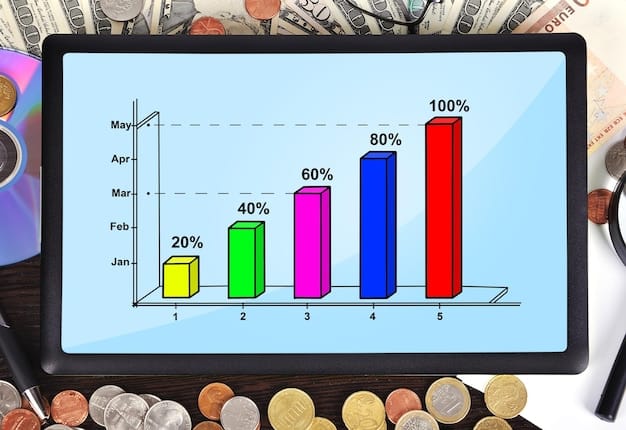The Power of Compound Interest: Grow Your Savings Exponentially

The power of compound interest lies in its ability to generate earnings from both the initial principal and the accumulated interest, creating exponential growth over time, making it a cornerstone of effective long-term financial planning and wealth accumulation.
Unlock your financial potential by understanding the power of compound interest: how to grow your savings exponentially over time. This principle allows your earnings to generate further earnings, accelerating your wealth accumulation.
Understanding the Basics of Compound Interest
Compound interest is a fundamental concept in finance that can significantly impact your long-term financial success. It’s essentially earning interest on your initial investment plus the accumulated interest from previous periods.
Unlike simple interest, which only calculates interest on the principal amount, compound interest allows your money to grow at an accelerating rate, turning small savings into substantial wealth over time.
Simple Interest vs. Compound Interest
To fully grasp the power of compound interest, it’s helpful to compare it with simple interest. Simple interest is calculated only on the principal amount, meaning you earn the same amount of interest each period.
Compound interest, on the other hand, adds the earned interest back to the principal, creating a larger base for future interest calculations. This compounding effect is what drives exponential growth.

- Simple Interest: Interest earned only on the principal amount.
- Compound Interest: Interest earned on both the principal and accumulated interest.
- Growth Trajectory: Linear growth with simple interest, exponential growth with compound interest.
- Long-Term Impact: Limited wealth accumulation with simple interest, significant wealth accumulation with compound interest.
In essence, the power of compound interest: how to grow your savings exponentially over time is about making your money work harder for you. By reinvesting your earnings, you’re essentially creating a snowball effect that can lead to significant financial gains.
The Formula for Calculating Compound Interest
While the concept of compound interest is straightforward, understanding the formula behind it provides valuable insights into how your savings can grow. The formula allows you to calculate the future value of an investment based on several key factors.
By understanding the formula, you can project the potential growth of your investments, adjust your savings strategies, and make informed decisions about your financial future. The compound interest formula is as follows:
Understanding the Variables
The compound interest formula is expressed as: A = P (1 + r/n)^(nt)
Where:
- A: The future value of the investment/loan, including interest
- P: The principal investment amount (the initial deposit or loan amount)
- r: The annual interest rate (as a decimal)
- n: The number of times that interest is compounded per year
- t: The number of years the money is invested or borrowed for
Each variable plays a crucial role in determining the final value of your investment. You have more control over the principal amount (P) and even the number of years (t), compared to the rate. Once you understand all the variables of the power of compound interest: how to grow your savings exponentially over time; you can potentially create a snowballing effect.
Understanding these variables is essential for accurately calculating compound interest and planning your investment strategy accordingly. Altering any of these variables can significantly impact the future value of your investment, highlighting the importance of careful financial planning.
The Frequency of Compounding Matters
One of the key factors that influence the power of compound interest: how to grow your savings exponentially over time is the frequency of compounding. The more frequently your interest is compounded, the faster your money will grow.
Different financial institutions offer varying compounding frequencies, such as annually, semi-annually, quarterly, monthly, or even daily. Understanding how these frequencies impact your returns can help you make informed decisions when choosing investment accounts.
Comparing Compounding Frequencies
Let’s look at how different compounding frequencies can affect the growth of a $10,000 investment over 10 years, assuming an annual interest rate of 5%:
If compounded annually: A = 10000 (1 + 0.05/1)^(1*10) = $16,288.95
If compounded semi-annually: A = 10000 (1 + 0.05/2)^(2*10) = $16,386.16
If compounded quarterly: A = 10000 (1 + 0.05/4)^(4*10) = $16,436.19
If compounded monthly: A = 10000 (1 + 0.05/12)^(12*10) = $16,469.88
- Annual Compounding: Interest is calculated and added once per year.
- Semi-Annual Compounding: Interest is calculated and added twice per year.
- Quarterly Compounding: Interest is calculated and added four times per year.
- Monthly Compounding: Interest is calculated and added twelve times per year.
As you can see, the more frequently interest is compounded, the higher the future value of the investment. Even though the difference may seem small, over longer periods and with larger principal amounts, these variations can become significant.
The Impact of Time on Compound Interest
Time is one of the most critical elements in the power of compound interest: how to grow your savings exponentially over time. The longer your money has to grow, the more substantial the compounding effect becomes.
Starting early and staying consistent with your savings can make a significant difference in your long-term financial outcomes. Let’s consider two individuals, Sarah and Tom, to illustrate the impact of time on compound interest.

The Early Bird Catches the Worm
Sarah starts investing $3,000 per year at age 25, earning an average annual return of 7%. She continues this until age 65. Tom starts investing $4,000 per year at age 35 (10 years later), also earning an average annual return of 7%. He also continues until age 65.
Even though Tom invests more money, Sarah ends up with more money by the time they both turn 65 due to the exponential growth that comes from the power of compound interest: how to grow your savings exponentially over time.
By starting earlier, Sarah gives her money more time to grow, allowing the compounding effect to work its magic. Even though Tom invests a larger amount annually, the extra decade of compounding significantly boosts Sarah’s returns.
- Early Start: Starting to save and invest early in life allows for a longer period of compounding, resulting in greater wealth accumulation.
- Consistency: Regular contributions, even if small, can add up significantly over time due to the compounding effect.
- Time Horizon: The longer the time horizon, the more pronounced the effects of compound interest become.
By consistently saving and investing over time, you can harness the power of compound interest to achieve your financial goals.
Strategies to Maximize Compound Interest
To truly harness the power of compound interest: how to grow your savings exponentially over time, it’s essential to implement effective strategies that maximize your returns. These strategies include starting early, increasing your principal, reinvesting earnings, and optimizing your investment choices.
By combining these approaches, you can supercharge your wealth accumulation and achieve your financial goals more efficiently. Here are some strategies to consider:
Reinvesting Earnings and Optimizing Investments
One of the simplest ways to maximize compound interest is to reinvest all earnings back into your investment. This ensures that your money continues to grow on an ever-increasing base. Also, you can also look into stocks for investments that yield higher rates.
Be cautious with stocks, however, since they are more sensitive to market fluxuations. It is important to do your own research or seek the help of an advisor to achieve the best possible outcomes.
- Start Early: Begin saving and investing as early as possible to take advantage of the long-term compounding effect.
- Increase Principal: Gradually increase the amount you save and invest over time to accelerate the growth of your wealth.
- Reinvest Earnings: Always reinvest any dividends, interest, or capital gains back into your investments to maximize compounding.
- Optimize Investments: Make informed investment choices that align with your risk tolerance and financial goals.
By implementing these strategies, you can enhance the effects of compound interest and build a more secure financial future.
In conclusion, the power of compound interest: how to grow your savings exponentially over time lies in combining consistent savings habits, strategic reinvestment, and knowledgeable investment selection. These elements, when synchronized, create the most favorable conditions for wealth creation.
Real-Life Examples of Compound Interest
The power of compound interest: how to grow your savings exponentially over time is not just a theoretical concept; it’s a real-world phenomenon that has helped many individuals achieve financial success. Understanding how compound interest works in practice can provide valuable motivation and insights for your own financial journey.
From retirement accounts to real estate investments, compound interest plays a crucial role in long-term wealth accumulation. Here are a couple of examples for you to consider:
Retirement Savings Growth
Retirement accounts like 401(k)s and IRAs are excellent examples of how compound interest can build substantial wealth over time. By contributing regularly to these accounts and reinvesting earnings, individuals can take full advantage of the compounding effect.
Let’s say you contribute $5,000 annually to a 401(k) that earns an average annual return of 8%. After 30 years, your initial contributions and reinvested earnings could grow to a significant amount. This growth is largely due to the power of compound interest, which allows your money to make money.
- 401(k)s and IRAs: These retirement accounts allow for tax-advantaged savings and compounding of investment returns.
- Real Estate: Investing in rental properties can provide a steady stream of income, which can be reinvested to acquire additional properties.
- Dividend Reinvestment Plans (DRIPs): DRIPs allow investors to automatically reinvest dividends received from stocks, buying additional shares and further compounding.
The key takeaway is that compound interest affects all investment options and contributes to the value of your assets. When selecting an investment, it’s important to learn whether or not you can reinvest the returns to grow your wealth.
| Key Point | Brief Description |
|---|---|
| 📈 Start Early | Begin saving and investing as early as possible |
| 💰 Reinvest Earnings | Always reinvest dividends and earnings |
| ⏳ Time is Key | The longer the investment, the better the return |
| 🎯 Optimize investments | Seek investment options that have higher return and reinvest profits. |
Frequently Asked Questions
▼
Compound interest is calculated on the initial principal, which also includes all of the accumulated interest from previous periods. It leads to the exponential growth of your savings over time.
▼
The compounding schedule depends on your investment options. If possible, compounding your assets monthly is the most recommended. This can contribute to significant gains over time.
▼
The compound interest formula is expressed as: A = P (1 + r/n)^(nt). It includes calculations of the initial investment, compounding frequency, and annual interest rates.
▼
Time is one of the most essential elements that contribute to compound interest. The longer you save money, the higher the exponential compounding interest. Start saving as early as possible!
▼
The best way to maximize compound interest is to reinvest the earnings, increase the principal through regular and consistent payments, and optimize investments. Also, starting early is also essential!
Conclusion
In conclusion, understanding and leveraging the power of compound interest: how to grow your savings exponentially over time is essential for achieving long-term financial security. By starting early, staying consistent, and making informed investment decisions, you can unlock the potential of compounding and grow your wealth exponentially. Embrace the concept of the power of compound interest: how to grow your savings exponentially over time to achieve financial freedom and fulfill your lifelong dreams.





